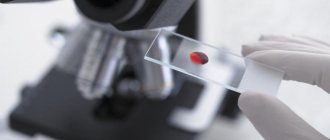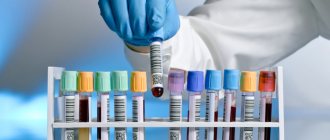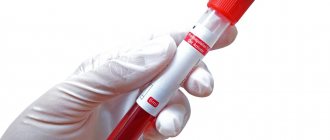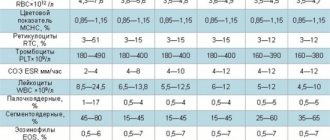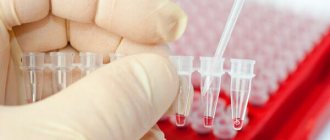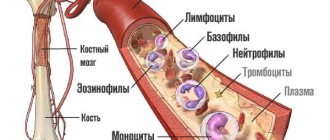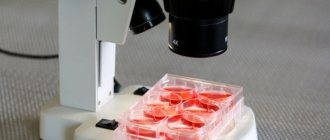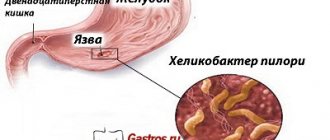In the article we will look at what this means - prothrombin according to Quick is increased.
Modern medicine makes it possible to conduct high-precision research, helping to diagnose serious pathological diseases in the early stages. One of them is the Quick test of prothrombin in the blood. What are the goals of conducting such a study? What do its results indicate?
The norm of prothrombin index and prothrombin will be given below.
Properties
Prothrombin is a complex protein actively involved in the process of blood clotting. The biosynthesis of protein molecules occurs in the liver. Such a complex process requires many microelements and requires a large proportion of vitamin K. It has been proven that deficiency of the latter synthesizes abnormal molecules that can form blood clots - deadly blood clots that interfere with normal blood flow. The main property of prothrombin is to normalize blood clotting. It is for this purpose that a coagulogram is used, which makes it possible to determine the presence of blood pathologies in patients. Thanks to the prothrombin index, which characterizes the level of blood clotting, it makes it possible to obtain a detailed picture of a particular disease. Prothrombin is sometimes called a laboratory test, but these concepts must be differentiated. Prothrombin analysis allows you to calculate the rate of blood clotting, and prothrombin is directly involved in this process.
If prothrombin according to Quick is elevated, not everyone knows what this means.
What is prothrombin, what are its functions?
Thrombin is the end product of prothrombin conversion reactions
Prothrombin is a plasma protein involved in the coagulation process. Its level is an important factor for the optimal functioning of the hemostatic mechanism, therefore, in the diagnosis of hemocoagulation and various diseases, prothrombin is given much attention.
Prothrombin originates in the liver; a necessary element for its formation is vitamin K. Having penetrated the bloodstream, the protein circulates in an inactive state until the integrity of the vessel is damaged. Once this happens, a chain of reactions is set in motion that prevents blood loss. All coagulation factors sequentially activate each other; factor X and factor V, in the presence of calcium ions, form a complex with tissue phospholipids that affects prothrombin. Prothrombin is converted to thrombin, which breaks down the next factor fibrinogen, forming a blood clot.
Indications for analysis
A specialist may prescribe such a patient’s blood clotting test in the following cases:
- in the presence of bleeding disorders, which are characterized by prolonged bleeding;
- with a decrease in the performance of liver enzymes and the liver itself;
- when monitoring blood clotting during the use of anticoagulants;
- if there is a suspicion of the presence of oncological blood pathologies in the body.
There are other indirect indications for such a blood test, determined individually for each patient. The analysis is most often carried out for women whose age is from 45 to 60 years. The structure of the blood, its qualitative and quantitative characteristics change against the background of hormonal changes.
During this time period, a woman’s body is especially susceptible to the development of cancer, which such a study will help diagnose.
The doctor will tell you what it is - prothrombin according to Quick.
When is prothrombin considered low?
Prothrombin is a complex element of blood serum, because it quickly dissolves in plasma, and it is difficult to isolate it from other proteins. Therefore, during diagnosis, the activity of this substance is assessed.
The best, most accurate result will be given by assessing the PT according to the Quick system. This system was developed at the beginning of the 20th century by scientist A. Quick; a blood sample is taken from a vein from the patient, and two biological activators are added to the plasma - calcium chloride and thromboplastin. Together with these substances, the plasma reacts; one can observe in what period of time and with what force the blood thickens. The results of PT according to Quick are based on a table of prothrombin index activity at different time intervals, indicated on the form as a percentage.
The prothrombin index according to Quick, which is in the range of 78-142%, is considered normal. A patient with such indicators does not have any health problems. But if the coefficient is below 78%, this is a reason to worry.
Scale for assessing the norm of PT by age:
- Up to 7 years – 78-100%;
- From 7 to 12 years – 80-102%;
- From 12 to 18 years – 78-112%;
- From 18 to 25 years – 83-115%;
- From 25 to 45 years – 78-135%;
- From 45 to 70 years – 78-142%
There is no difference within the normal range based on gender. The age of the patient undergoing the tests plays a big role.
Preparing for the study
Blood is taken before 11 o'clock in the morning. The most accurate results are observed when performing the analysis on an empty stomach. It is important to prepare for the study by following these recommendations:
- 2-3 days before the test, refuse fatty fried foods and strong alcoholic drinks, which additionally burden the liver;
- the patient must stop smoking three hours before the blood test, since nicotine can cause a sharp decrease in the prothrombin index;
- if continuous use of medications is necessary, their use should be discontinued six hours before the study;
- limit physical activity that causes fatigue;
- Blood sampling is not recommended for women during the menstrual period, when the blood in the body is renewed;
- During pregnancy, the study results will also have their own errors; the norm shifts by several points.
Blood taken from a vein is placed in a test tube with saline solution. Then the tube is placed in a centrifuge, waiting for the plasma to separate. The latter will be examined in more detail later.
When prothrombin according to Quick is elevated, what does this mean interests many.
What does increased prothrombin mean?
An increased prothrombin time indicates that the blood is clotting faster than it should. This is an abnormal phenomenon, as it leads to an increase in blood viscosity, the blood circulation process slows down, and blood vessels can become clogged with blood clots.
The reasons for this may lie in such serious pathologies of internal organs as:
- the presence of malignant processes;
- polycythaemic disease;
- angina pectoris in a progressive form;
- pathological processes in the liver;
- thromboembolism;
- disorders of the gastrointestinal tract;
- pathologies in which fibrin polymerization is disrupted and the concentration of antithromboplastin increases;
- high levels may indicate kidney problems, so you should consult a nephrologist. The person may have nephrotic syndrome or renal amyloidosis.
If the content of this protein has increased, this means that it is urgently necessary to undergo a comprehensive examination and determine the causes of this phenomenon.
Other factors can also cause such a deviation:
- Abuse of Aspirin, anabolic steroids, laxatives, treatment with antibacterial drugs, anticoagulants, nicotinic acid. Long-term use of hormonal contraceptives.
- Increased levels of vitamin K in the blood. This problem can be caused by disturbances in the functioning of the organs that produce this substance and excessive consumption of foods that contain a lot of this vitamin.
- Sometimes an increase in prothrombin is observed in women during pregnancy. This problem usually occurs late in pregnancy and requires immediate treatment. Therefore, while carrying a child, women are recommended to take this test in order to promptly identify abnormalities that may complicate the course of pregnancy and childbirth.
- Transfusion of large amounts of blood.
- Hyperglobulinemia or vasculitis.
- Blood levels of antibodies to coagulation factor II.
The reasons for increased prothrombin levels are quite varied, so systematic blood tests will help identify the problem at the very beginning.
What studies help establish prothrombin?
There are several forms that allow you to determine the degree of prothrombin:
- Prothrombin according to Quick is the most accurate and popular method of analyzing blood plasma for coagulation, the result obtained is a percentage that reflects the activity of the plasma prothrombin complex for a certain period of control plasma. In other words, the proportion of plasma activity by the time of its clotting in a control sample of material is Quick's prothrombin. PTI, PTV will be described below.
- The prothrombin index INR, that is, the International Normalized Ratio, is a relative analysis that does not have ultra-precise indicators. It is effective in situations where it is necessary to constantly monitor coagulation when treating a person with indirect anticoagulants.
- PTI, or prothrombin index. Its results are the opposite of the analysis indicated above, allowing one to establish the proportion of normal prothrombin time to the indicators of the diagnosed patient. This study is outdated, as there are many analogues that have more accurate data.
- PTT, or prothrombin time, is a numerical indicator that reflects the rate of blood clotting.
The norms of prothrombin, index and time are given below.
It is necessary to take into account that the INR study is relative, because it only allows one to obtain the prothrombin index of the analyzed blood sample to normal generally accepted values. INR is not always prescribed as a routine examination. It is most often used by WHO experts who work in the microbiology industry. The INR values differ somewhat from the Quick results, but the meaning of the analysis is similar. Quick research makes it possible to obtain expanded results. This analysis can be done in the presence of errors, since its high accuracy allows you to establish the prothrombin time and index more accurately.
Let's look at the indicators and norm of prothrombin according to Quick.
Video clip “Why is a prothrombin index test prescribed”
Based on materials from www.probirka.org
Modern medicine allows for highly accurate research , helping to diagnose complex pathological diseases in the early stages. One of these is the Quick blood prothrombin test. For what purposes is such an analysis carried out, what makes it possible to determine, and what its results indicate, we will analyze further.
Prothrombin is a complex protein that takes an active part in the process of blood clotting. Biosynthesis of the protein molecule occurs in the liver. This complex process requires many microelements, mostly vitamin K. It has been proven that a lack of this vitamin leads to the synthesis of abnormal molecules that can form blood clots - fatal blood clots that interfere with normal blood flow.
The main function of prothrombin is to normalize blood clotting . It is for these purposes that a coagulogram is used, which allows one to determine the presence of blood pathologies. The prothrombin index, which characterizes the degree of blood clotting, allows you to get a detailed idea of the presence of a particular disease.
Sometimes prothrombin is called a laboratory test, but these concepts should be separated.
Prothrombin analysis helps determine the rate of blood clotting, and prothrombin itself is directly involved in this process.
A doctor may prescribe a similar blood test for coagulation in several cases:
- there are problems with blood clotting, characterized by prolonged bleeding;
- when the performance of the liver and liver enzymes is reduced;
- there are suspicions of blood cancer;
- when monitoring coagulation during the period of taking anticoagulants.
There are other indirect reasons for conducting such a blood test, which are determined on an individual basis.
Most often, the analysis is carried out for women aged 45-60 years . Against the background of hormonal changes, the structure of the blood and its quantitative and qualitative composition change.
Anna Poniaeva. Graduated from the Nizhny Novgorod Medical Academy (2007-2014) and Residency in Clinical Laboratory Diagnostics (2014-2016).Ask a question>>
Read more about the analysis and in what cases it is prescribed
During this period of time, the female body is most susceptible to the development of cancer, which a similar blood test will help identify.
Blood is drawn
in the morning until 11 o'clock . The most accurate results are obtained if blood is taken on an empty stomach. It is important to prepare for the analysis by following these recommendations:
- 2-3 days before the test, avoid fried fatty foods and strong alcoholic drinks, which pose an additional burden on the liver.
- .3 hours before blood sampling, the patient should not smoke, since nicotine can cause a sharp decrease in the prothrombin index.
- If there is a need to take medications on a regular basis, you should stop using them 6 hours before blood sampling.
- Limit physical activity that leads to fatigue.
It is not recommended to take blood from women during menstruation, when blood is being renewed. During pregnancy, test results have their own errors, shifting the norm by several points.
Blood taken from a vein is placed in a test tube with a special saline solution. After this, the test tube is placed in a centrifuge and the plasma is waited for separation, which is subsequently subjected to a more detailed examination.
There are several forms that allow you to determine the level of prothrombin in the blood:
- Prothrombin according to Quick is the most popular and most accurate method for testing plasma for coagulation, in which the result obtained is a percentage reflecting the activity of the plasma prothrombin complex over a certain time of control plasma. To put it simply, prothrombin according to Quick is the ratio of plasma activity to its clotting time in the control sample.
- The prothrombin index INR (International Normalized Ratio) is a relative analysis that does not have ultra-precise data. It is effective when there is a need for constant monitoring of coagulation when treating a patient with indirect anticoagulants.
- Prothrombin index - the results are the opposite of the above analysis, allowing you to determine the ratio of normal prothrombin time to the results of the patient being studied. This analysis is considered outdated, since there are many of its analogues that have more accurate indicators.
- Prothrombin time is a numerical indicator that displays the rate of blood clotting.
It is worth considering that the INR analysis is relative, since it provides only the prothrombin index of the blood sample being studied in relation to generally accepted normal values.
INR is not always prescribed as a routine examination. Most often, INR is used by WHO experts working in the field of microbiology. The INR indicators have some discrepancies with the Quick results, but the meaning of the study is similar. Quick analysis allows you to get advanced results . Such a study can be done in the presence of errors, since its high accuracy helps determine the prothrombin index and time more accurately.
As mentioned earlier, Quick analysis allows you to determine two important indicators:
- prothrombin index - an indicator calculated by relating the normal results of prothrombin time to the results of the test blood sample;
- prothrombin time is the time in seconds during which prothrombin proteins are able to influence plasma coagulation.
Prothrombin analysis according to Quick allows you to determine prothrombin time and prothrombin index by constructing a control graph that displays coagulation indicators as a percentage during two phases of hemostasis.
It is worth considering that the interpretation of the analysis performed may be individual for each laboratory. This depends on indicators such as:
- individually established standards;
- quality of reagents and modernization of equipment;
- features of the patient’s medical history (taking anticoagulants, antibiotics and other medications that affect indicators).
The results of the study are presented in the form of a graph, which displays control points showing the degree of blood clotting at a certain time .
The norms for prothrombin indicators are shown in the table.
Based on materials from 1pokrovi.ru
What are the analysis metrics?
It was previously said that the Quick analysis makes it possible to determine two significant indicators: prothrombin time - the time in seconds during which prothrombin proteins can affect plasma coagulation; prothrombin index - a value that is calculated by the proportion of normal prothrombin time values to the data of the patient’s test material.
Quick's prothrombin analysis helps establish the prothrombin index and time by constructing a control graph displaying the percentage of coagulation parameters during the two hemostasis phases.
How to increase prothrombin levels
In addition to drug therapy, the percentage of PT in the blood can be increased by adjusting the patient’s lifestyle.
To do this, you need to follow the following recommendations:
- avoid drinking alcohol and smoking;
- play sports (hiking in the fresh air, running, swimming);
- moderate physical activity;
- avoid stressful situations, control your emotional state.
Exercising will help increase prothrombin
During an increase in the prothrombin index in the blood, it is important to pay attention to nutrition.
It is recommended to avoid:
- fatty, salty, smoked and fried foods;
- legumes (beans, peas), herbs and some vegetables (cabbage, beets, peppers);
- baked goods and flour products;
- buckwheat porridge.
Fish and fish oil, citrus fruits, onions and garlic, and ginger well increase the percentage of PT. It is necessary to include raspberries, cranberries, strawberries, and figs in the diet. For cereals, it is useful to eat oatmeal, and for drinks, drink green tea.
Folk remedies
Among alternative medicine recipes there are many effective ways to have a positive effect on blood clotting.
Corn silk decoction
Place medicinal raw materials (2 tbsp) in an enamel pan, pour 500 ml of boiling water and boil in a water bath for 7–10 minutes. Strain the cooled broth and take 0.5 cups 3 times a day for a week.
Corn silk decoction has a beneficial effect on prothrombin levels
Tincture from walnuts (shells)
Pour nut shells into a half-liter jar (do not tamp) and fill to the top with vodka (moonshine). Leave the liquid to infuse in a warm place (out of direct sunlight) for 7–10 days. Take the strained tincture 35–40 drops no more than 3 times a day.
To prepare the tincture you need to use nut shells
Decoction of knotweed and yarrow
Take equal parts of herbs (1 tablespoon each) and pour 0.5 liters of boiling water. Boil the vegetable liquid over low heat for 5–7 minutes. The decoction should be drunk 1/3 cup in the morning, at lunch and before bed.
A decoction of knotweed will help increase prothrombin levels
Stinging nettle infusion
Pour boiling water (250 ml) over the crushed leaves of the plant (20 g) and leave for 30–40 minutes. Take ½ cup of the healing liquid in the morning and evening.
Nettle will increase prothrombin levels
Treatment with folk remedies not only increases coagulation, but also stimulates metabolism, and also improves the functioning of the heart and digestive system. The main thing is to comply with all dosages.
Indicators of prothrombin norm according to Quick, PTI PTV
It must be borne in mind that the interpretation of this study may be individual in each laboratory. This depends on such parameters as: standards established individually; modernization of equipment and quality of reagents; the specifics of the patient’s medical history (use of antibiotics, anticoagulants and other drugs that affect indicators). The results of the study are presented in the form of a graph displaying control points that show the degree of blood clotting at a certain time.
Age standards are as follows:
- from birth to six years – from 80 to 100%;
- from six to twelve – from 79 to 102%;
- from twelve to eighteen – from 78 to 110%;
- from eighteen to twenty-five – from 82 to 115%;
- from 25 to 45 – from 78 to 135%;
- from 45 to 65 – from 78 to 142%.
For women and men, the indicators are almost identical; they depend, for the most part, on the presence of a particular pathology in the patient, and not on gender. Prothrombin time normally ranges from nine to twelve seconds. This time is considered optimal, characterizing blood clotting.
What is the normal prothrombin index for women during pregnancy?
For women during pregnancy, a mandatory test is a coagulogram containing a mandatory item - prothrombin time or prothrombin index. If they are higher or lower than normal, then this is a reason for a more detailed examination and hospitalization of the patient. Typically, in women during pregnancy, the prothrombin index is in the range of 85-152%.
What is prothrombin index?
PTI in the blood is an indicator that reflects the speed at which blood coagulation starts along its internal pathway. It is calculated based on prothrombin time. A low prothrombin index is associated with the same factors as a decrease in PT.
The normal prothrombin index for women is approximately 95%. The normal prothrombin index in men is slightly higher and is about 105%. The accuracy of the analysis depends on many factors, for example, the drugs used in the laboratory.
Features of decoding: what does a deviation from the norm indicate?
When the research results obtained are higher or lower than generally established norms, this means that there are certain disorders in the body. Usually the transcript is provided to the person in the form of a table, which indicates not only the percentage, but also the reasons for deviations in the values. A low prothrombin index indicates the following disorders: vitamin K deficiency; improper functioning of the pancreas and liver; long-term use of drugs that affect blood clotting.
So, Quick prothrombin is below normal, what should you do?
Why is analysis needed?
Coagulation is a very important system in our body. Coagulation is necessary for a person to stop bleeding when injured. This feature allows us to live without worrying about the fact that we may bleed from a banal cut on our finger. Normally, the PTI rate in a healthy person ranges from 70 to 140%.
Deviations in one direction or the other indicate a violation of this process, which can lead to dangerous consequences.
A biochemical blood test is necessary to determine the level of prothrombin and PTI in the blood. Prothrombin is a protein compound synthesized by liver cells with the participation of vitamin K. Prothrombin during the coagulation chain is converted into thrombin, a blood clotting substance. With some liver diseases or with a lack of vitamin K, prothrombin in the blood decreases, which leads to bleeding of various locations.
PTI blood test - what is it? This is a study of the rate of clotting, which depends on the amount of prothrombin in it. The study shows how long it takes for a clot to form. This biochemical blood test is extremely important to take before any surgical treatment and childbirth. After all, if doctors do not know about coagulation abnormalities, this can lead to death.
Below normal
It should be noted that a low prothrombin index becomes a provoking factor for the occurrence of bleeding. The lower the score, the higher the risk of severe bleeding leading to death.
Signs of a low prothrombin index may be values characteristic of diseases of the gastrointestinal tract and liver. In this case, weight loss, weakness and changes in taste buds are observed. However, the most important indicator is heavy bleeding from a small cut. If there is an abrasion on the elbow, a person can lose 300 ml of blood if he has a low prothrombin index.
What does it mean if prothrombin according to Quick is increased?
What does a decreased PT indicate?
Prothrombin according to Quick is reduced, what does this mean? The prothrombin index and susceptibility to bleeding are interrelated. A low level indicates that the blood serum is very thin, and any wound or operation may result in life-threatening bleeding.
A low prothrombin index may occur in the following cases:
- Taking anticoagulants that reduce blood clotting by suppressing fibrin in plasma. Popular anticoagulants are Aspirin Cardio, Heparin, Phenilin, Wafarin, Clexane.
- Lack of potassium produced in the liver. Potassium increases the activity of PT, increases the number of blood elements responsible for coagulation. Deficiency is most often observed in diseases of the digestive tract, liver, and gall bladder.
- Medicines - diuretics, laxative tablets, antibiotics, acetohexamide, steroids, oral contraceptives, nicotinic acid in large quantities, acetylsalicylic acid and quinine.
- High levels of heparin in the blood serum.
- Genetic predisposition.
- Hypovitaminosis.
The following diseases of the gastrointestinal tract and liver can reduce the prothrombin index:
- Chronic, acute pancreatitis.
- Oncology of the pancreas, liver, gall bladder.
- Hepatitis of acute, chronic type.
- Cirrhosis.
- Mechanical jaundice.
- Cholecystitis.
- Dysbacteriosis.
- Liver failure.
Above normal
If, on the contrary, the readings are higher than normal, this indicates the following health problems: high content of the active clotting inhibitor - heparin; increased synthesis of vitamin K; thrombophlebitis and thromboembolism; heart problems (pre-infarction condition and heart attack); formation of malignant neoplasms.
It should be noted that an increased value indicates that the blood viscosity is too strong, as a result of which its transport and throughput capabilities are reduced. Any violations of the norm must be investigated in detail. An increased or decreased prothrombin level is a reason to undergo a comprehensive examination to identify the real causes of the disorders.
Study of PC during pregnancy
During pregnancy, a coagulation test is necessarily prescribed to women as a necessary analysis, which is part of the coagulogram along with the coagulation index. Thanks to the decoding of the analysis on the PC and the coagulation index, the doctor will be able to closely monitor the patient’s health and avoid many serious complications.
Is it normal to have a decrease in prothrombin according to Quick?
It must be said that during pregnancy, a woman’s PC rate is slightly lowered due to the formation of a new circle of blood circulation from her to the child. In addition, higher than normal levels help prepare for severe blood loss during childbirth. With increased PC during pregnancy, severe bleeding during childbirth, including internal bleeding, may develop. Inattention to this indicator can cause hemolytic shock. This disorder causes a higher mortality rate during childbirth than other causes. If the indicator is below normal, coagulants are prescribed. During pregnancy, a decrease in PC threatens the patient with vascular blockage, thrombosis and related complications. In such situations, doctors most often prescribe thinning agents - anticoagulants (Warfarin).
We looked at the decoding and values of the prothrombin norm according to Quick.
How to reduce prothrombin levels
The method of reducing prothrombin coincides with the methods of increasing it. A healthy lifestyle, exercise, quitting smoking and alcohol, and a proper diet are the main ways to get rid of high blood viscosity.
Folk remedies
The most effective methods for reducing PT are considered to be recipes that contain honey, lemon, garlic or onions.
Medicinal mixture
Grind onion (200 g) and garlic (100 g), add 110 ml of honey and 60 ml of lemon juice. Combine all components and mix until smooth. Take the finished drug 1 tsp. several times a day.
A mixture of onion, garlic and honey reduces prothrombin levels well
Beet salad with garlic
Boil the beets well, peel and grate on a fine grater. Add 1 clove of garlic and 2 tbsp. l. vegetable oil, mix everything. Beet salad should be present in the daily diet for 7-12 days.
Beetroot salad with garlic is not only tasty, but also healthy
Apple-honey infusion
Wash and cut 3 medium apples into small slices, place in a 1-2 liter thermos. Add 50 g of green tea and 15 ml of honey. Pour boiling water over everything and leave for 2.5 hours. The medicinal drink should be drunk throughout the day. Every morning you need to make a new infusion. The course of treatment is 5–7 days.
Apple-honey infusion should be drunk within 24 hours
